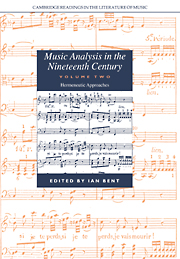Book contents
- Front matter
- Contents
- Preface to volumes I and II
- List of abbreviations
- General introduction
- Part I: Elucidatory analysis
- Part II: Objective–subjective analysis: the hermeneutic circle
- Introduction
- Analysis 8 Jérôme-Joseph de Momigny (1762–1842)
- Analysis 9 Ernst Theodor Amadeus Hoffmann (1776–1822)
- Analysis 10 Robert Schumann (1810–1856)
- Analysis 11 Abramo Basevi (1818–1885)
- Analysis 12 Adolf Bernhard Marx (1795?–1866)
- Analysis 13 Theodor Helm (1843–1920)
- Afterword to volumes I and II
- Bibliographical essay
- Index to Volumes I and II
Analysis 10 - Robert Schumann (1810–1856)
‘[Review of Berlioz: Fantastic Symphony]’ (1835)
Published online by Cambridge University Press: 10 December 2009
- Front matter
- Contents
- Preface to volumes I and II
- List of abbreviations
- General introduction
- Part I: Elucidatory analysis
- Part II: Objective–subjective analysis: the hermeneutic circle
- Introduction
- Analysis 8 Jérôme-Joseph de Momigny (1762–1842)
- Analysis 9 Ernst Theodor Amadeus Hoffmann (1776–1822)
- Analysis 10 Robert Schumann (1810–1856)
- Analysis 11 Abramo Basevi (1818–1885)
- Analysis 12 Adolf Bernhard Marx (1795?–1866)
- Analysis 13 Theodor Helm (1843–1920)
- Afterword to volumes I and II
- Bibliographical essay
- Index to Volumes I and II
Summary
‘To attempt a closer analysis of [the Fantastic Symphony of Berlioz], to dissect the underlying ideas, thoroughly poetic as they are, and the final articulated form in all its perfection — truly this would be as vain a pursuit as to analyse the “Eroica” Symphony of Beethoven’. This remark, printed in Robert Schumann's Neue Zeitschrift für Musik on 22 December 1834, is full of contradictions and ironies.
For a start, the first person to publish a close analysis of the ‘Eroica’, only three years later, was none other than Hector Berlioz; and the first to do likewise for the Fantastic Symphony a year later was Schumann. Moreover, the term Zergliederung (‘dissect’ here is Zergliederung geben), is the very word that Schumann himself was to use with such ironic effect in his own review by allusion to Berlioz's earlier studies in anatomy when a medical student (see the Introduction to Part I of vol. I for an extended discussion of terms related to dissection as components of musicanalytic language).
To take this remark at face value, however, would be unwise since it is a translation from French: the original was an unsigned concert report in the Gazette musicale de Paris of 9 November 1834. To compare the French with the German is to show how languages reflect their own cultural values as much as they do any common body of meaning.
- Type
- Chapter
- Information
- Music Analysis in the Nineteenth Century , pp. 161 - 194Publisher: Cambridge University PressPrint publication year: 1994

